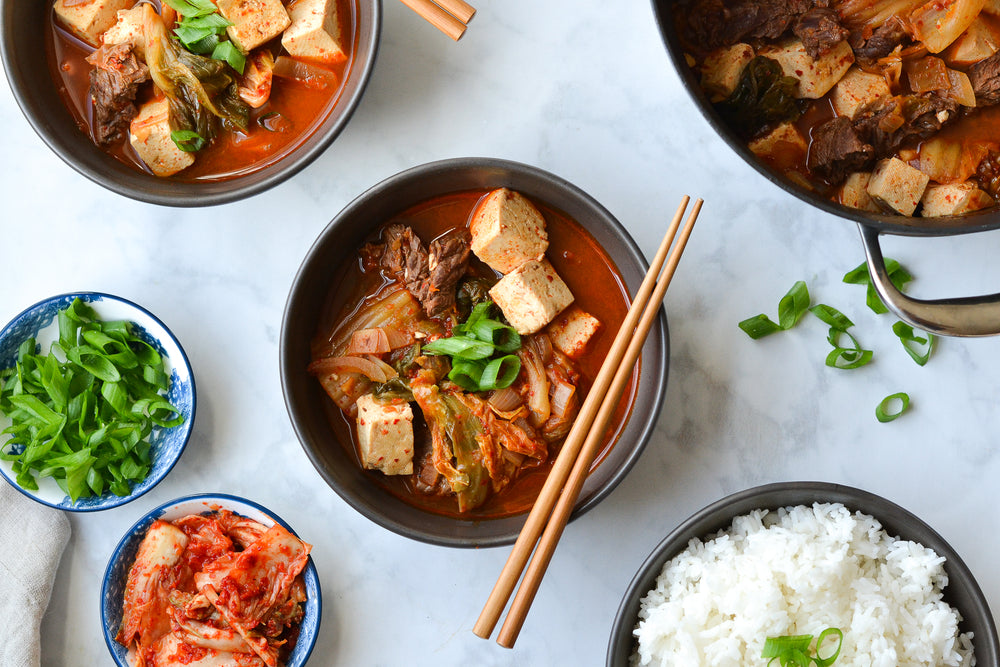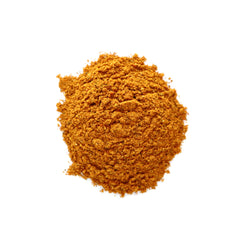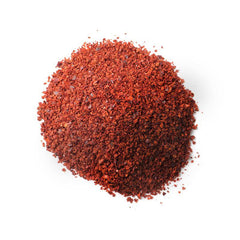Recipes
Korean Spicy Beef Stew (Kimchi Jigae)

Serves 4-6
| Prep Time: 10 mins
| Cook Time: 35 mins
| Total Time: 45 mins
You may need: Korean Gochugaru

Discover The Recipe
Winter in Korea tends to be bitterly cold, with a steady northwest wind that whips down from Siberia. To combat the winter chill, Korean cuisine features fiery and flavorful soups and stews that warm the belly and soul. This Korean Spicy Beef Stew (Kimchi Jigae), is not your basic beef stew. Tender chunks of beef are bathed in an aromatic broth that is enlivened by the addition of Kimchi, a traditional food made by fermenting cabbage with spices like chilis. Kimchi is served on almost every Korean dinner table and is packed with umami, sour, and salty flavor.
Traditionally, baking or frying were not common Korean cooking methods, which use boiling and blanching, and preserved their summer harvests by fermenting, seasoning/salting, and pickling, methods which are featured in their cuisine today. In this Korean Spicy Beef Stew (Kimchi Jigae) recipe, we add Gochugaru made of authentic Korean chili flakes, which provide a fruity, smoky, and mild heat balanced by a touch of sweetness. If you don’t like a lot of spicy heat, select a mild Kimchi and reduce the Gochugaru to your taste. Serve this dish with fragrant jasmine rice. Try using Gochugaru to make an authentic Korean BBQ beef (Bulgogi) recipe on our website.
Ingredients
1 Tbsp toasted sesame oil, divided
1 lb beef (sirloin or flank steak)
½ onion, chopped
2 cloves garlic, diced
1 Tbsp Piquant Post Gochugaru
2 cups napa cabbage kimchi
1 Tbsp low sodium soy sauce
3 cups water
1 block firm tofu, cut in 1 in cubes
2 green onions, sliced (optional)
Cooked jasmine rice, for serving
Notes
Sirloin and flank steak are tougher and leaner cuts of meat. They will become more tender the longer it simmers in liquid. For even tougher cuts of meat such as round, chuck, or short rib, simmer the meat for longer, up to 1 hour in step 3, then add the tofu as the final step.
There are many different types of kimchi, but the most common, and type that we use here is baechu kimchi, or napa cabbage kimchi. Most supermarkets and online stores carry Kimchi and there are mild and spicy hot varieties to choose from.
Common veggies to add are potatoes, mushrooms, and bok choy. Add to the boiling stew and simmer until cooked to desired likeness.
Kimchi Jigae is often served in a bubbling hot pot as the centerpiece of the table and for the group to share.
Optional ingredients add a little character and flavor but don’t sweat it if you don’t have them.
Instructions
Add 1/2 tablespoon of the sesame oil to a soup pot over Med-High heat; once hot, add the beef and sauté to brown the meat, about 2-3 minutes per side. Remove beef and set aside.
Add remaining sesame oil to pot. Add onion and sauté for 2-3 minutes. Add garlic and Korean Gochugaru chilis, then sauté for 1 minute. Add in kimchi and soy sauce and stir to mix. Add water and beef to the pot. Bring to a boil, then reduce heat to med-low to simmer.
Simmer the stew for 10 minutes, then add the tofu. Simmer for another 10 minutes, stirring occasionally.
Remove stew from heat and serve with hot jasmine rice and sliced green onions.
Alternatives & Substitutions
Substitute the beef with pork belly, or double up on tofu and add glass noodles and vegetables.
Korean Gochugaru chilis can be used as a unique condiment to sprinkle on anything to add a fruity, mild heat.
Try using Korean Gochugaru in our Korean BBQ Beef Bulgogi, our Vegan Dakgalbi, or make a delicious Kimchi Fried Rice recipe and add 1 Tbsp gochugaru chili flakes to the kimchi when stir frying.
Add flavor to these Kimchi Summer Rolls and sauce, or make a side Spicy Cucumber Salad, or try our Spicy Pork Bulgogi Bowl.
For a vegan option, try making a Korean Bibimbop bowl with Gochugaru mushrooms for a hearty and healthy meal.
Put on your chef’s hat for this Chinese and Korean influenced Sichuan Boiled Fish.
Be sure to leave comments and feedback on your meals and experiments in the comments for others to read.
Post pictures of your masterpiece meal on social media and tag us. We repost!
Korean Spicy Beef Stew (Kimchi Jigae)
Serves
4-6
Prep Time
10 mins
Cook Time
35 mins
Total Time
45 mins
Piquant Post spice you'll need: Korean Gochugaru

Ingredients
1 Tbsp toasted sesame oil, divided
1 lb beef (sirloin or flank steak)
½ onion, chopped
2 cloves garlic, diced
1 Tbsp Piquant Post Gochugaru
2 cups napa cabbage kimchi
1 Tbsp low sodium soy sauce
3 cups water
1 block firm tofu, cut in 1 in cubes
2 green onions, sliced (optional)
Cooked jasmine rice, for serving
Instructions
Add 1/2 tablespoon of the sesame oil to a soup pot over Med-High heat; once hot, add the beef and sauté to brown the meat, about 2-3 minutes per side. Remove beef and set aside.
Add remaining sesame oil to pot. Add onion and sauté for 2-3 minutes. Add garlic and Korean Gochugaru chilis, then sauté for 1 minute. Add in kimchi and soy sauce and stir to mix. Add water and beef to the pot. Bring to a boil, then reduce heat to med-low to simmer.
Simmer the stew for 10 minutes, then add the tofu. Simmer for another 10 minutes, stirring occasionally.
Remove stew from heat and serve with hot jasmine rice and sliced green onions.
Notes
Sirloin and flank steak are tougher and leaner cuts of meat. They will become more tender the longer it simmers in liquid. For even tougher cuts of meat such as round, chuck, or short rib, simmer the meat for longer, up to 1 hour in step 3, then add the tofu as the final step.
There are many different types of kimchi, but the most common, and type that we use here is baechu kimchi, or napa cabbage kimchi. Most supermarkets and online stores carry Kimchi and there are mild and spicy hot varieties to choose from.
Common veggies to add are potatoes, mushrooms, and bok choy. Add to the boiling stew and simmer until cooked to desired likeness.
Kimchi Jigae is often served in a bubbling hot pot as the centerpiece of the table and for the group to share.
Optional ingredients add a little character and flavor but don’t sweat it if you don’t have them.






